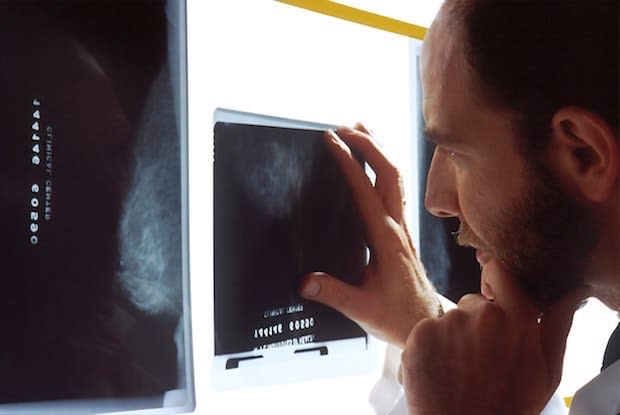Table of Contents
II. Symptoms of Prostate Problems
III. Benign Prostatic Hyperplasia
Understanding the Prostate
The prostate is an essential gland within the male body. The prostate weighs about 30 grams and surrounds the urethra beneath the bladder. This gland’s main function is to secrete prostate fluid. There are muscles in the gland that propel seminal fluid into the urethra during ejaculation. When ejaculation occurs, sperm moves from the vas deferens to the prostate, closing the opening between the bladder and urethra, allowing semen to push through. The fluid created by the prostate makes up around one-third of the semen volume. [1]
This gland is vital to the functioning of the male reproductive system, but it can experience several problems due to its location in the body. Because the prostate is located around the urethra, it has the liability to swell or grow, resulting in problems. The most common types of prostate problems include prostatitis, prostate cancer, and enlarged prostate (benign prostatic hyperplasia). Read on to learn more about these disorders and the treatments available, like Cialis and Androcur. [2]
Symptoms of Prostate Problems
Symptoms of prostate disorders can vary depending on the type. Some commonly reported prostate problem symptoms could include:
- A frequent urge to urinate
- Blood in urine or semen
- Painful ejaculation
- Need to get up several times in the night
- Dribbling of urine
- Painful or burning urination
- Stiffness in the hips, lower back, upper thighs, and pelvic or rectal area [3]
For many men, getting up several times a night for bathroom runs is the first sign of prostate problems. This is especially true in the case of an enlarged prostate. Frequent urination is typically a byproduct of getting older, but prostate problems can occur in any man. If you feel that you are urinating more frequently than normal, you should seek a doctor's help. [4]
Benign Prostatic Hyperplasia
This disorder has several names, including enlarged prostate, benign prostate hyperplasia, or BPH. According to the National Kidney and Urological Disease Information, this is the most common prostate problem in men over 50 years old. By 60, over half of men have BPH, and that number increases to 90 percent by the time a man reaches his eighties. [4]
BPH occurs when the prostate grows and blocks the flow of urine through the urethra. As the urethra narrows, more force is required to push urine out of the body. The body eventually grows accustomed to this bladder pressure, which results in a thicker and more sensitive bladder muscle. This sensitivity can lead to bladder contraction, even if the bladder contains small amounts of urine. Over time, a narrowed urethra can make it so that the bladder never properly drains.
If BPH is left untreated, a man may experience frequent urinary tract infections, bladder stones, blood in the urine, incontinence, and an inability to urinate. It is essential to seek immediate medical help if you cannot urinate. In severe cases, bladder and kidney damage can occur. [4]
Treatment for BPH depends on the severity of your condition. Medication is the most common treatment for mild to moderate symptoms of BPH. Some common medications include: Alpha-Blockers: These drugs are typically used in combination treatments for BPH. Alpha-blockers lower blood pressure and relax the muscles in the walls of arteries and veins. Along with blood vessels, alpha-blockers can relax other muscles like the prostate muscle, improving urine flow. 5-Alpha Reductase Inhibitors: These drugs work to shrink your prostate by manipulating the hormones that cause the prostate to grow. It may take up to six months to see the full results of these drugs. Cialis: A small dosage of this erectile dysfunction drug has been shown to treat prostate enlargement. Talk to your doctor to determine if Cialis is right for you. [5] Inflammation of the prostate gland characterizes prostatitis. Infection typically causes this inflammation. Around 10 to 12 percent of all men may experience prostatitis symptoms at some point in their lives. This condition is the most common type of prostate problem in men over 50 years old. [6] There are several types of prostatitis, including: Chronic Bacterial Prostatitis: This condition is a rare condition resulting in recurring infections of the prostate gland. Swelling, inflammation, and frequent urinary tract infections are common symptoms of chronic bacterial prostatitis. Other symptoms may include painful ejaculation, blood in the urine or semen, and foul-smelling urine. Sexually transmitted infections can cause these infections. Enlarged prostate, an infection in or around the testicles as well as a narrowed urethra may also lead to chronic infections. [7] Acute Bacterial Prostatitis: This type of prostatitis occurs suddenly and can include flu-like symptoms. This infection of the prostate gland can lead to pelvic pain, urinary tract infections, as well as symptoms like nausea, fevers, and chills. Acute bacterial prostatitis makes up around 10 percent of all prostatitis cases, so it is the least common of the prostatitis types. [8] Chronic Prostatitis/Chronic Pelvic Pain Syndrome: This category encompasses the majority of all prostatitis cases. This type can be inflammatory or noninflammatory, depending on if infection-fighting cells are present in the urine, semen, and prostatic fluid. There is no specific cause of chronic prostatitis, and the symptoms can come and go in flare-ups. [6] Asymptomatic Inflammatory Prostatitis: As its name suggests, this type can go unnoticed due to its lack of symptoms. Those with asymptomatic prostatitis will not complain of symptoms, but they will have infection-fighting cells in their semen/prostatic fluid. [6] Urine and blood tests can help determine if the prostate is infected. Treatment for prostatitis depends on the cause. Most commonly, antibiotics are used to treat infections of the prostate. Your doctor will run tests to determine what type of bacteria is causing your infection. Antibiotics will be prescribed depending on the results of that test. Alpha-blockers may also be used to relax the bladder muscles and ease symptoms like painful urination. NSAIDs (nonsteroidal anti-inflammatory drugs) can also be used to ease the pain. [9] Prostate cancer is one of the most common types of cancer in men. In 2020, an estimated 191,930 men in the United States will be diagnosed with prostate cancer. This diagnosis occurs most commonly in men 65 and over. Around 90 percent of diagnosed men will catch the disease when the cancer is only present in the prostate and nearby organs. [10] Prostate cancer is the second leading cause of cancer-related death in men. Luckily, the death rate for this disease has dropped significantly over the last few decades. When it is caught early, the survival rate for prostate cancer is better than most other cancers. [10] Prostate cancer may have no signs or symptoms in the early stages, which can make diagnosis difficult. More advanced signs of prostate cancer can include: Advanced age, family history, and overall health can contribute to a person’s risk of developing prostate cancer. Obese men are more likely to have advanced prostate cancer upon diagnosis. Prostate cancer can result in metastasizing cancers and spread to nearby organs like the bladder. It can also result in incontinence as well as erectile dysfunction. A doctor may perform a digital rectal exam (DRE) by inserting a lubricated finger into the rectum to examine the prostate. This can help determine abnormalities in the gland. DREs can be used alongside blood tests to identify prostate-specific antigens in the blood. If high levels of antigens are in the blood, then the prostate may be infected, inflamed, or affected with cancer. [11] There are several different treatments for prostate cancer. Immediate treatment may not be necessary if you have low-risk prostate cancer. You and your doctor can keep an eye on your cancer to see if it progresses and whether more aggressive treatment is necessary. Regular blood tests, rectal exams, and biopsies are required for active surveillance. In the case of more advanced prostate cancers, your doctor may recommend radiation treatment or surgeries to remove any cancerous tissues. Hormone therapy drugs like Androcur can stop the body from producing testosterone and also help improve prostate cancer. [11] Thankfully, you can now buy Androcur online from a Canadian Pharmacy, saving you up to 90 percent! The content in this article is intended for informational purposes only. This website does not provide medical advice. In all circumstances, you should always seek the advice of your physician and/or other qualified health professionals(s) for drug, medical condition, or treatment advice. The content provided on this website is not a substitute for professional medical advice, diagnosis or treatment.
a. Treatment
Prostatitis

a. Treatment
Prostate Cancer

a. Treatment

